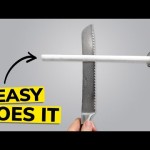Keeping your knives sharp is essential for any kitchen. Whether you are a professional chef or a home cook, having sharp knives is essential for preparing food safely and efficiently. A honing stone is a great tool for keeping your knives sharp and in good condition. In this article, we will discuss the basics of sharpening your knives with a honing stone, including the types of honing stones available, the steps involved in sharpening your knives, and the benefits of using a honing stone.
How do you sharpen a knife with a honing stone
Sharpening a knife with a honing stone is a great way to keep your knives in top condition. A honing stone is a flat, abrasive stone that is used to sharpen and hone the blade of a knife. It is important to use the correct technique when sharpening a knife with a honing stone, as it can be dangerous if done incorrectly. Here are some tips on how to sharpen a knife with a honing stone.
Step 1: Prepare the Honing Stone
Before you begin sharpening your knife, you need to prepare the honing stone. Start by soaking the stone in water for 10-15 minutes. This will help to remove any debris and dirt from the stone. Once the stone is soaked, use a damp cloth to wipe it down and remove any excess water.
Step 2: Position the Knife
Once the honing stone is prepared, you can begin sharpening the knife. Place the knife on the stone with the blade facing away from you. Make sure the blade is positioned at a 20-degree angle. This will ensure that the blade is sharpened evenly.
Step 3: Sharpen the Knife
Now you can begin sharpening the knife. Start by pushing the blade away from you in a smooth, even motion. Make sure to keep the blade at the same angle as you move it across the stone. After each stroke, rotate the blade slightly and repeat the process. Continue this process until the blade is sharp.
Step 4: Test the Blade
Once you have finished sharpening the blade, it is important to test it. To do this, take a piece of paper and place it on a flat surface. Then, take the knife and make a slicing motion on the paper. If the blade is sharp, it should easily cut through the paper. If it does not, you may need to repeat the sharpening process.
Conclusion
Sharpening a knife with a honing stone is a great way to keep your knives in top condition. It is important to use the correct technique when sharpening a knife with a honing stone, as it can be dangerous if done incorrectly. By following the steps outlined above, you can easily sharpen your knife with a honing stone and keep it in top condition.
Is honing better than sharpening
Sharpening and honing are two different processes used to maintain the sharpness of a blade. Both processes involve the removal of metal from the blade, but the way in which they do it is different. Sharpening involves the use of a sharpening stone or other abrasive material to grind away metal from the blade, while honing involves the use of a honing stone or other abrasive material to smooth out the blade’s edge.
The question of whether honing is better than sharpening is a matter of personal preference. Sharpening is more aggressive and can be used to restore a blade’s edge after it has become dull. Honing, on the other hand, is a gentler process and is used to maintain the sharpness of a blade.
Sharpening is often used when a blade has become very dull and honing is used to maintain the sharpness of a blade. Sharpening can be done more frequently than honing, but it is also more likely to damage the blade if done incorrectly. Honing is a gentler process and is less likely to damage the blade, but it is also less effective at restoring a blade’s edge.
The choice between honing and sharpening depends on the condition of the blade and the desired result. If the blade is very dull, sharpening is the best option. If the blade is only slightly dull, honing is the better choice.
In conclusion, honing and sharpening are both effective ways to maintain the sharpness of a blade. The choice between the two depends on the condition of the blade and the desired result. Sharpening is more aggressive and is best used when the blade is very dull, while honing is gentler and is best used to maintain the sharpness of a blade.
Do you wet a stone before sharpening a knife
Sharpening a knife is an important part of maintaining a kitchen. It is important to keep your knives sharp and in good condition. One of the most common methods of sharpening a knife is to use a sharpening stone. But do you need to wet the stone before sharpening a knife?
The answer is yes, you should wet the stone before sharpening a knife. Wetting the stone helps to create a slurry, which is a mixture of water and the metal particles that are removed from the blade when sharpening. This slurry helps to lubricate the blade and the stone, making it easier to sharpen the knife. It also helps to reduce the amount of heat generated during the sharpening process, which can damage the blade.
When wetting the stone, it is important to use the correct amount of water. Too much water can cause the stone to become too slippery, making it difficult to sharpen the knife. Too little water can cause the stone to become too dry, which can also make it difficult to sharpen the knife. The best way to wet the stone is to use a spray bottle and lightly mist the stone with water.
Once the stone is wet, it is important to use the correct sharpening technique. Start by placing the blade on the stone at a 20-degree angle and move the blade in a circular motion. Make sure to keep the blade at the same angle throughout the sharpening process. After a few passes, you should be able to see a burr on the blade, which indicates that the blade is sharp.
In conclusion, it is important to wet the stone before sharpening a knife. This helps to create a slurry, which lubricates the blade and the stone, making it easier to sharpen the knife. It also helps to reduce the amount of heat generated during the sharpening process. When wetting the stone, it is important to use the correct amount of water and to use the correct sharpening technique.
How do you use a honing stone
A honing stone is a tool used to sharpen and refine the edges of knives, chisels, and other cutting tools. It is made of a hard material, usually aluminum oxide or silicon carbide, and is available in a variety of shapes and sizes. Using a honing stone is a simple process that requires a few basic steps.
Step 1: Prepare the Stone
Before you begin sharpening, you must prepare the honing stone. Soak the stone in water for 10-15 minutes, then remove it and let it dry. This will help to remove any debris or dirt that may be on the stone.
Step 2: Apply Oil or Water
Once the stone is dry, you must apply either oil or water to the surface. Oil is best for honing stones made of aluminum oxide, while water is best for stones made of silicon carbide. Apply a few drops of oil or water to the stone and spread it evenly with a cloth.
Step 3: Sharpen the Blade
Now you are ready to sharpen the blade. Hold the blade at a 20-degree angle and move it across the stone in a circular motion. Make sure to keep the blade at the same angle throughout the process. Apply light pressure and move the blade in a consistent pattern. After a few passes, you should begin to see a sharp edge on the blade.
Step 4: Test the Edge
Once you have finished sharpening the blade, you should test the edge. To do this, take a piece of paper and draw a line on it. Then, take the blade and try to cut the line. If the blade cuts the line cleanly, then the edge is sharp. If not, repeat the sharpening process until the blade is sharp.
Step 5: Clean the Stone
Once you have finished sharpening the blade, you must clean the honing stone. Use a cloth to wipe away any oil or water that is left on the stone. Then, rinse the stone with water and let it dry before storing it away.
Using a honing stone is a simple process that can help to keep your knives and other cutting tools sharp. With a few simple steps, you can easily sharpen and refine the edges of your blades.
Thank you for reading this article about sharpening your knives with a honing stone. We hope you have found it helpful and informative. Goodbye and take care!















